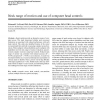Free Online Productivity Tools
i2Speak
i2Symbol
i2OCR
iTex2Img
iWeb2Print
iWeb2Shot
i2Type
iPdf2Split
iPdf2Merge
i2Bopomofo
i2Arabic
i2Style
i2Image
i2PDF
iLatex2Rtf
Sci2ools
ASSETS
2000
ACM
2000
ACM
Neck range of motion and use of computer head controls
Abstract—Head controls provide an alternative means of computer access. This study determined whether neck movement limitations are associated with reduced performance with such head controls. This study also identified features of the cursor movement path that could aid in assessing computer access limitations. Fifteen subjects without disabilities and ten subjects with disabilities received neck range of motion evaluations and performed computer exercises using head controls. Reduced neck range of motion was correlated with reduced accuracy (R2 = 93.5%) and speed (R2 = 79.5%) in icon selection. A model was developed with the use of cursor positioning time and number of velocity peaks to identify when a person was having difficulty with target acquisition (κ = 0.81). Models such as this may allow head controls to adapt to a user’s needs, accommodating difficulties resulting from neck range of motion limitations. Key words: computer access, head controls, man-machine systems, mult...
| Added | 01 Aug 2010 |
| Updated | 01 Aug 2010 |
| Type | Conference |
| Year | 2000 |
| Where | ASSETS |
| Authors | Edmund F. LoPresti, David M. Brienza, Jennifer Angelo, Lars Gilbertson, Jonathan Sakai |
Comments (0)

